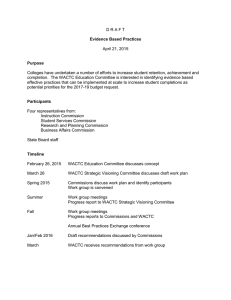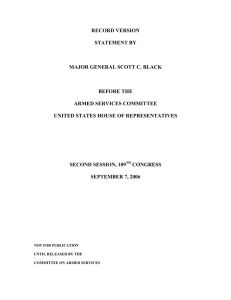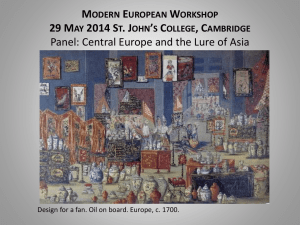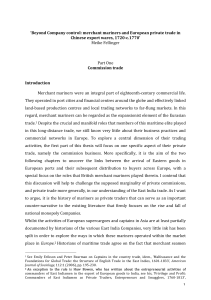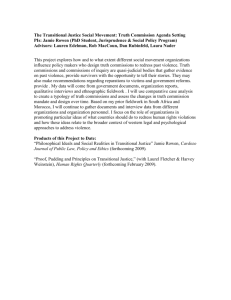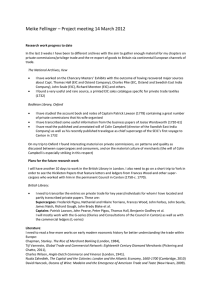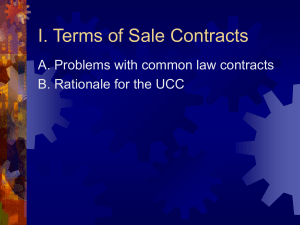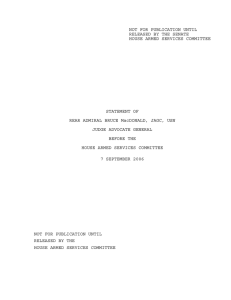EHS Residential Training Course for PhD students in Economic and... 2012 Manchester 28 November to 1 December 2012
advertisement
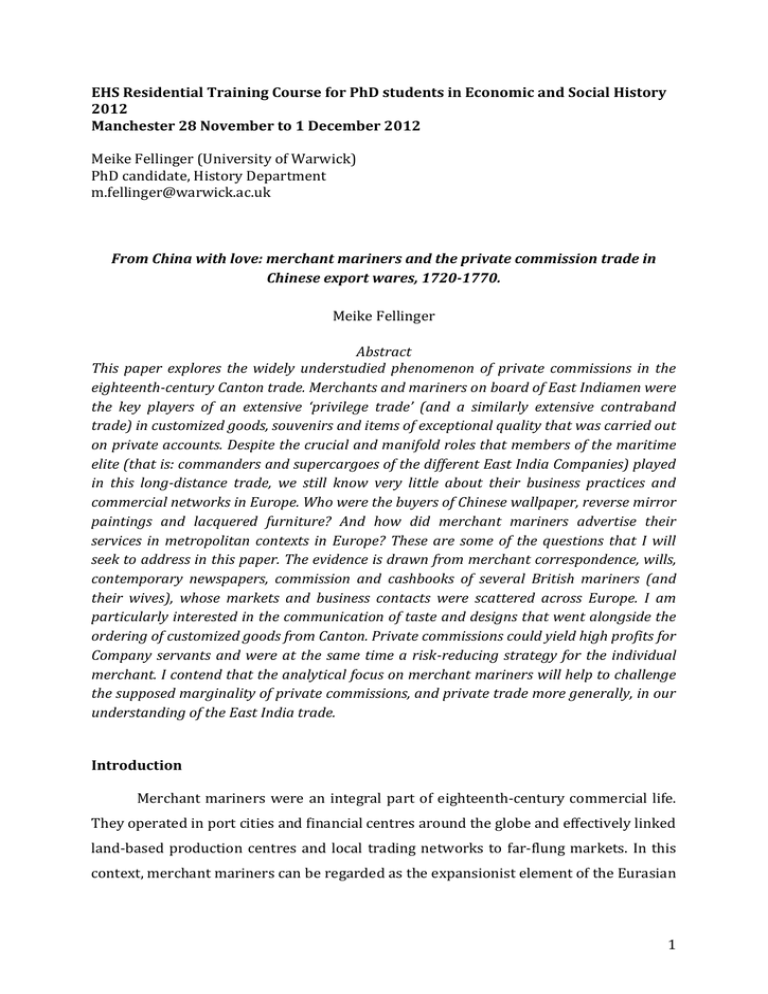
EHS Residential Training Course for PhD students in Economic and Social History
2012
Manchester 28 November to 1 December 2012
Meike Fellinger (University of Warwick)
PhD candidate, History Department
m.fellinger@warwick.ac.uk
From China with love: merchant mariners and the private commission trade in
Chinese export wares, 1720-1770.
Meike Fellinger
Abstract
This paper explores the widely understudied phenomenon of private commissions in the
eighteenth-century Canton trade. Merchants and mariners on board of East Indiamen were
the key players of an extensive ‘privilege trade’ (and a similarly extensive contraband
trade) in customized goods, souvenirs and items of exceptional quality that was carried out
on private accounts. Despite the crucial and manifold roles that members of the maritime
elite (that is: commanders and supercargoes of the different East India Companies) played
in this long-distance trade, we still know very little about their business practices and
commercial networks in Europe. Who were the buyers of Chinese wallpaper, reverse mirror
paintings and lacquered furniture? And how did merchant mariners advertise their
services in metropolitan contexts in Europe? These are some of the questions that I will
seek to address in this paper. The evidence is drawn from merchant correspondence, wills,
contemporary newspapers, commission and cashbooks of several British mariners (and
their wives), whose markets and business contacts were scattered across Europe. I am
particularly interested in the communication of taste and designs that went alongside the
ordering of customized goods from Canton. Private commissions could yield high profits for
Company servants and were at the same time a risk-reducing strategy for the individual
merchant. I contend that the analytical focus on merchant mariners will help to challenge
the supposed marginality of private commissions, and private trade more generally, in our
understanding of the East India trade.
Introduction
Merchant mariners were an integral part of eighteenth-century commercial life.
They operated in port cities and financial centres around the globe and effectively linked
land-based production centres and local trading networks to far-flung markets. In this
context, merchant mariners can be regarded as the expansionist element of the Eurasian
1
trade.1 Despite the crucial and manifold roles that members of this maritime elite played
in this long-distance trade, we still know very little about their business practices and
commercial networks in Europe. To explore a central dimension of their trading
activities, this paper will focus on one specific aspect of their private trade, namely the
commission business. More specifically, it is the aim of the following study to uncover
the links between the arrival of Eastern goods in European ports and their subsequent
distribution to buyers across Europe, with a special focus on the roles that British
merchant mariners played therein. I contend that this will help to challenge the
supposed marginality of private commissions, and private trade more generally, in our
understanding of the East India trade. Thus the history of mariners as private traders
can serve as an important counter-narrative to the existing literature that firmly focuses
on the rise and fall of national monopoly Companies.
Whilst the activities of European supercargoes and captains in Asia are at least partially
documented by historians of the various East India Companies, very little research has
been conducted in order to explore the ways in which these mariners operated within
the market place in Europe.2 Historians of maritime trade agree on the fact that
merchant seamen were crucial for the success of the Companies’ trade and for the
expansion of commercial activity in the Indian Ocean and China seas.3 In fact, they were
highly respected by contemporaries for the unique range of navigational skills, trading
knowledge and practical expertise that they acquired in the long-distance trade with
China and South Asia.4 However, the question to what extent merchant seamen were
On captains in the country trade see Emily Erikson and Peter Bearman, ‘Malfeasance and the
Foundations for Global Trade: the Structure of English Trade in the East Indies, 1601-1833’, American
Journal of Sociology, 112:1 (2006), pp. 195-230.
2 An exception to the rule is Huw Bowen, who has written about the entrepreneurial activities of
commanders of East Indiamen in the export of European goods to India, see his, ‘Privilege and Profit:
Commanders of East Indiamen as Private Traders, Entrepreneurs and Smugglers, 1760-1813’,
Internatonal Journal of Maritime History, XIX, No.2 (2007), pp.43-88. For the China trade, Roger Smith has
offered a piece on the private trade of British supercargoes and commanders in clocks and sing-songs for
the Chinese market and discusses in some detail the ways in which mariners teamed up with Londonbased clockmakers and merchants to create profitable goods for export to Canton. See, Roger Smith, ‘The
Sing-Song Trade: Exporting Clocks to China in the Eighteenth Century.’ Antiquarian Horology, 30, 2008, pp.
629–658. For a quantitative account of the private trade conducted by Company servants in Canton, see
Earl H. Pritchard, ‘Private Trade between England and China in the Eighteenth Century (Concluded),
Journal of the Economic and Social History of the Orient, 1:2 (1958), pp. 221-256.
3 A few key texts have focused on the various aspects of European commercial activity in the Asian coastal
trade, the so-called country trade. See, among others, I.B. Watson, Foundation for Empire: English Private
Trade in India, 1659-1760 (New Delhi, 1980); B.R. Tomlinson, ‘From Capsie to Kedgeree: Scottish
Enterprise, Asian Trade and the Company Raj’, Modern Asian Studies, 36:4 (2002), pp. 769-791. On Asian
private trade among VOC servants, see Chris Nierstrasz, In the Shadow of the Company: the Dutch East
India Company and its Servants in the Period of its Decline (1740-1796) (Leiden, forthcoming!).
4 See H.V. Bowen, ‘Privilege and Profit’ p. 44f.
1
2
part of a mercantile community of wholesalers and retailers specialising in the making
of markets for Chinese export wares in Europe has not yet been answered – or even
properly asked. The evidence presented in this paper will thus be used to show that the
private trade activities of British commanders and supercargoes rarely ran alongside
national-political boundaries. On the contrary, I will argue that the British maritime elite
functioned as essential linchpins in pan-European ordering networks for Chinese wares,
and took an active part in the making and shaping of markets across Europe.
In order to better understand the import, circulation and selling of Chinese consumer
goods in Britain and Europe (and the role played by merchant mariners therein), we
have to understand the very processes through which such orders could be placed. The
first section is therefore dedicated to the definition and explanation of different types of
commissions of the private trade in Chinese consumer goods during the first half of the
eighteenth century. The second section will then be used to explore the ways in which
commanders and supercargoes managed small-scale commissions en detail. The aim
here is to sketch a portrait of merchant mariners as distributors as well as consumers of
Chinese export wares.
The examples I have chosen for this paper reflect only those commissions that directly
linked individual consumers to the actual importer and first seller. The many
middlemen (wholesalers, retailers, peddlers) that were usually involved in the
distribution of Asian goods to European consumers are missing in this particular branch
of the commission trade. Consumers were thus acquainted with those agents who
supplied the goods. Since commercial access to Chinese goods was very much limited
throughout the period under consideration through the loophole of the Canton trade, it
was necessary for collectors and elite consumers in Europe to maintain personal
connections with individual Company servants. Friendship, kin and business relations
were the gateways through which most customized wares from China reached British
and indeed European shores in the first half of the eighteenth century. In that respect,
the private trade differed greatly from the ways in which the monopoly Companies
disposed of their merchandise – via ascending-bid auctions (called the ‘English auction’)
that were attended by wholesale dealers rather than elite consumers.
The chartered Companies did leave this trade in oddities and expensive items entirely to
their mobile servants abroad. The latter were thus able to forge contracts with
consumers in preparation of their actual voyage to Canton. This surely led to the
reduction of the considerable commercial risk that merchants faced on such ventures.
3
After their return some 18 to 24 months later, officers were allowed to request the
delivery of freight-free goods to their clients from the private trade warehouses, by
circumventing the public sales. As we will see, the directors of the various Companies
seem to have been major beneficiaries of this privilege trade. As powerful patrons of
individual captains and supercargoes they heavily used this channel for accumulating
vast collections of fine luxury goods. They commissioned goods for later sale, personal
use and to fuel the early modern gift economy that linked statesmen and merchants
alike.
Typologies of commissions in the China trade
The literature on the decorative arts in Europe and most curatorial studies of
Chinese export wares such as porcelain, wrought silks, watercolour paintings, and
lacquerware acknowledge the decisive role that private trade played in providing a
gateway through which fine quality wares, souvenirs, and customized pieces could enter
markets in Europe. The most substantial and sophisticated literature on private trade
goods exists for Chinese export porcelain, and a small number of these studies focus
exclusively on commissioned wares – the so-called chine de commande.5 The objectbased research of art historians has led to the identification of a chronology of styles and
techniques in pottery and painting that were in use during the period of this study.
The study of seventeenth- and eighteenth-century shipwrecks of East Indiamen has
provided much evidence that can help us to better distinguish the official Company
trade in porcelain from that carried out on private accounts. According to the surviving
sources, the EIC ordered predominantly coarse and middling qualities of blue & white
and polychrome tableware. By contrast, merchant seamen in her service obtained a
highly diverse range of fine quality pieces for individual consumers, merchants, patrons
and friends in Europe.6 The evidence for a single trading year can serve to illustrate this
fact. For instance, in 1774, as the art historian David S. Howard has shown, ‘only two
specified design patterns [were] ordered by the Hon. East India Company for over a
thousand pieces of enamelled ware, and four specified designs among an even larger
See, for instance, David S. Howard, The Choice of the Private Trader: The Private Market in Chinese Export
Porcelain illustrated from the Hodroff Collection (London, 1994); Rose Kerr and Luisa E. Mengoni, Chinese
Export Ceramics (London, 2011); C.J.A. Jörg, Porcelain and the Dutch China Trade, 1729-1794 (Leiden,
1982); Geoffrey A. Godden, Oriental Export Market Porcelain and its influence on European Wares (London,
1979).
6 Geoffrey A. Godden, Oriental Export Market Porcelain, p. 15.
5
4
quantity of blue & white.’ By contrast, it is clear that ‘apart from armorial ware – which
averaged about fifty annually – there were probably hundreds of other individual pieces
or designs chosen from Canton shops by servants of the East India Company.’7
Chinese and Japanese lacquerware in the form of panels, folding screens, cabinets, tea
tables and other costly items of household furniture seem to have been purchased
exclusively on private account.8 This was equally true for other fancy goods such as
mother-of-pearl snuffboxes, fans, wallpaper, painted glass and blanc de chine figures.9
The choice of the private trader is, by contrast, less obvious in the trade in Chinese silks,
cotton fabrics (nankeens) and tea. Crucially, supercargoes and captains often purchased
a wide range of qualities of these commodities, including cheap Bohea (a strongly
fermented black leaf tea of inferior quality). It is thus one of my central findings that the
general assumption that private traders only provided for the top-end of the market,
whereas the Companies targeted mass consumers of cheap but fashionable wares, does
not always hold true. As a consequence, a straightforward distinction between private
trade and Company goods is not always possible, or even particularly useful, to make.
The fact that private traders imported cheaper wares next to extravagant luxuries can
give us a clear hint to what extent the nature of private commissions could vary. What I
thus seek to show in this chapter is that the business ventures of captains and
supercargoes ranged from small-scale commissions (sometimes only a single item) to
wholesale enterprises and speculative purchases on a single voyage; a kaleidoscope of
activities that calls for a structured analysis with regard to the different types of buyers
involved.
I propose to differentiate between four different types of commissions executed through
the initiative of merchant mariners engaged in the China trade. In doing so, it is crucial
to account for change over time since access to Chinese wares greatly increased in the
middle decades of the eighteenth-century – not least due to the increased shipping of the
David S. Howard, The Choice of the Private Trader, p. 11.
In the first decade of the eighteenth century, there is some evidence pointing to the short-term Company
trade in lacquered fans, but this enterprise seems to have been given up quickly. The Court of Directors
reminded their outgoing supercargoes that ‘It is found by experience that they (Chinese artisans) Lacker
or Jappan better at Chusan than at Canton therefore be very curious in getting all the Lacquer'd or
Japann'd fans don well and by the best Workmen'. Quoted from, IOR/E/3/96 ff289-291v ‘List of Goods to
be provided at Chusan by the Supra Cargo's of the Rochester. Instructions to Supra Cargos are dated 6 Jan
1710 ('1709')’.
9 See Rose Kerr and John Ayers, Blanc de Chine: Porcelain from Dehua (London, 2002).
7
8
5
different chartered Companies.10 Around 1720, which marks the beginning of the period
of my study, special commissions were mainly undertaken by, and for, East India
Company personnel, associated ship owners, shareholders and their families. These
small-scale orders form the first group of my analysis. An important characteristic of
such commissions was that they were part and parcel of the dense patronage networks
that evolved around the East India trade. Gifts, favours and mutual obligations were thus
partly played out through the distribution of precious goods from China.
In order to analyse this branch of small-scale commissions, we can rely on somewhat
patchy but in many cases conclusive evidence in the form of mercantile correspondence,
account books, probate inventories, wills, sales catalogues and private trade registers. In
addition to lists and other written documents, there exists particularly rich evidence of
material culture. This is partly to be explained by the fact that customized goods are
often easier to relate to a particular buyer. What is more, since many of these objects
were displayed rather than used on a daily basis, there are myriad pieces that have
survived in museums and private collections up to the present day.
The second type of private commission became more frequent from the mid-eighteenth
century onwards, and encompassed orders from the upper middle-classes, the lower
gentry and aristocratic circles. Special commissions from China became fashionable
among these elite groups of society partly through the influence of East India Company
servants. The class of merchant mariners who plied the seas from the West Indies to
China and Sri Lanka were part of a new mercantile elite that became ever more powerful
in the urban centres of commerce, in politics and, lastly, in the polite circles of Europe.
The fact that these newly rich ‘seamen’ gradually mixed and mingled with the lower
gentry (and sometimes even with the high aristocracy, as well as artists and artisans)
had lasting (find another word) effects on patterns of consumption in Britain, and also
on the continent. To acknowledge these shifting epicentres for the commission business
from the urban environment (with connections to the East India trade) towards the
provinces and country houses, we need a different category. In the middle decades of the
eighteenth-century private commissions became desirable and accessible to a much
wider range of consumers, namely also for those without personal ties to Company
supercargoes and commanders. This shift towards a more anonymous ‘market for
In the 1750’s the English East India Company alone send about 20 ships to the East in one sailing
season. In the late eighteenth-century this number more than doubled to 50 ships per year. See, H.V.
Bowen, ‘Privilege and Profit’, p. 43f.
10
6
special commissions’, is neatly summarised by an announcement made in 1763, in the
London Chronicle, or Universal Evening Post, in which we can read:
‘On New Year's day was launch[ed] from Messrs Wells's deck in Deptford, a fine
ship for the service of the Hon. East India Company called the British King to be
commanded by Captain Peter Pigou. After the launch the Captain gave at the
Crown and Anchor in the Strand an elegant entertainment and a ball to a brilliant
assembly of near two hundred ladies and gentlemen of distinction.’11
These kind of large entertainments in a famous London coffeehouse were perfect venues
for attracting private commissions from ‘ladies and gentlemen of distinction’ that would
otherwise have to buy ready-made wares from the shops that specialised in
merchandise from China. The ball mentioned above took place shortly after Peter Pigou
(1732-1783) had become appointed master of this new ship. Pigou himself came from a
very wealthy Company family, with two of his brother being active supercargoes in
China and his father Frederick Pigou (1711-1792) serving as a powerful director of the
East India Company in London.12
We can perceive a further widening of the market for special commissions when
corporations, secret societies and companies discovered the potential of having their
group identity not only put on paper and rhetorically expressed in vows, but rather
materialised in the form of, for instance, elegant drinking vessels from China. The third
type of commissions thus came from institutions rather than from individuals. Since this
development falls in a slightly later period than looked at in the present study (mainly
towards the late eighteenth-century), I will only mention this phenomenon rather than
discuss it in any detail. Because of the great number of pieces ordered by such
institutions at once, some fine examples survive in museums today. David S. Howard
writes that ‘By the end of the century supercargoes, captains and officers of the English
East India Company alone had purchased special commissions in Canton’ for roughly
‘thirty livery companies, at least twenty societies and two regiments; and mugs,
punchbowls or plates for two inns, a breeches maker, a post office, a hat-maker, a boatThe London chronicle, or, Universal evening post, Volume 13. From Thursday, 30 December, to Saturday,
1 January 1763. Italics, my emphasis.
12 Frederick Pigou was chief supercargo on several voyages to China before he was appointed to the Court
of Directors (a position that he held almost uninterrupted between 1758 and 1777). His personal
instructions on how to distinguish the different qualities of Chinese silks were presented to many
supercargoes that went out to Canton under his patronage. He was also the co-owner of gunpowder mills
at Dartford, Kent. See E. D. Cook, ‘Andrews, Miles Peter (1742–1814)’, rev. Rebecca Mills, Oxford
Dictionary of National Biography, Oxford University Press, 2004; online edn, Oct 2009
[http://www.oxforddnb.com/view/article/528, accessed 25 June 2012].
11
7
builder, a ‘man-midwife’ and ‘George Harding, China Warehouse, No. 189 Minories’ in
London.’13
The last of the four different types of private commissions outlined here is probably the
one that has been the most inconspicuous of all of them in contemporary scholarship.
Nevertheless, as I would argue, it was the most widespread and in many respects most
influential with regard to market developments. From the early eighteenth century
onwards, wholesalers and retailers (such as mercers) sought to get hold of the best
wares from China, commodities in which they dealt in bulk in Europe. Soon, they
understood that access to the pacotille (that is the ‘privilege’ cargo of private traders on
board of East Indiamen) of merchant mariners was the best way to get new products,
new patterns and better qualities. The analysis of large-scale commissions that were
organised in partnership between wholesalers and mariners deserves, as my project will
make clear, much more attention by scholars of the East India trade, as much as it calls
for a closer examination from historians of retail and consumption. (In my oral
presentation, I will therefore develop this topic a bit further. To provide a point of
comparison, I will discuss the role that large-scale commissions from city-merchants
and professional ‘China dealers’ played in expanding the trade of Company servants
from the niche markets that I have outlined so far to largely anonymous and unfamiliar
markets across Europe.) I claim that European wholesale merchants exercised direct
influence on imports from China by setting up regular private commissions with
supercargoes and commanders of different East India Companies. In order to prove this
point, I will discuss in detail the crucial relationship between wholesale dealers in places
like London, Amsterdam, Cadiz and Stockholm on the one hand, and a group of British
mariners who were working under the aegis of different East India Companies on the
other. However, before we get to the functioning of large-scale commission we need first
to dwell on the first type of commission introduced above. The reason is that it provides
us with the right kind of background knowledge necessary to branch out to larger
market phenomena.
Families and consumers with association to the East India Companies
13
David S. Howard, The Choice of the Private Trader, p. 26.
8
The first type of commission is that ordered by staff and families associated with
the East India Companies. As Howard finds in his important study of private trade in
porcelain, ‘In England a comparatively small circle of families, related by blood or
background, succeeded both in directing what became the largest company in the world
and at the same time in acquiring much of the porcelain that survives today.’14 In fact,
the first armorial wares in England (ca. 1710) were all commissioned by affluent
Company servants, managing owners of East Indiamen, shareholders, directors, captains
and supercargoes.15 In France, the situation is comparable. In the first two decades of
the eighteenth century, most ‘orders came from the court, senior civil servants and
managerial staff of the Compagnie des Indes’.16 However, soon ‘families of standing in
the provinces, especially Britanny’ started to order family china, too. According to Louis
Mézin, their ‘proximity to Lorient [where the Company auctions took place] and
connections with families associated with the Compagnie des Indes fostered the growth
of the trade in private export china.’17
Dutch merchants might well have started the fashion for armorial wares as items of
regular trade, since most of the very early examples were made for Dutch families. Here,
the overall trend is similar to what happened in Britain and France: we are faced with an
extraordinary high proportion of commissions from VOC servants and financiers.18
Clearly, armorial wares helped this new mercantile elite in North Western Europe to
render visible their access to powerful ordering networks of what was in the beginning
of the eighteenth century still a fairly exclusive luxury trade.19 Large dinner sets
composed of up to 400 pieces of customized porcelain including sweetmeat dishes, fruit
baskets, tureens, punchbowls and knife handles were an impressive statement of wealth
and family identity. Armorial wares seemed to have offered the rare combination of
being modern consumer goods while clearly playing with notions of exclusivity, family
legacy and heritage. Such material attributes must have been particularly popular
among families that had only obtained recently their fortunes. In order to commission a
Ibid., p. 12.
See ibid.
16 Louis Mézin, Cargoes from China, chapter on ‘Family china’, pp. 153-181.
17 Ibid., p.153.
18 See C.J.A. Jörg, Porcelain and the Dutch China Trade, 1729-1794.
19 In his excellent study on the influences of Chinese porcelain on South-East Asia, Japan, the Middle East
and Europe, Robert Finlay described the slow beginning of the porcelain trade through Portuguese and
Spanish merchants, who initially supplied only the few royal dignitaries on the continent with porcelain.
This royal monopoly on Asian luxuries was only broken with the entrance of the Dutch into seaborne
trade in Asia. See idem., The Pilgrim Art: Cultures of Porcelain in World History (Berkeley, 2010), esp. pp.
254-261.
14
15
9
set of ‘family china’, painted wallpapers, or matching silks for curtains and bed hangings,
it was vital to approach supercargoes and commanders of East Indiamen directly.
Fig. 2 Chinese lacquered hall chair with the Child
coat of arms, at Osterley Park. Furniture made for
Sir Francis Child, the Younger in the 1720s.
©National Trust
This is mainly due to the fact that private commissions often involved the exchange of
written instructions, miniature models, patterns of fabric, portraits, drawings or
sketches of the design. A coloured drawing (or engraved book plate) featuring the
armorial bearings, crest and Latin motto of the family, would be provided as a model for
the production of customized porcelain.20 The fact that these coloured drawings were
indeed the main, and often sole, basis for the production of armorial ware by Chinese
manufacturers is reflected in the following telling anecdote. David S. Howard documents
the unfortunate commission of the London merchant Calverley Bewicke, who ordered a
porcelain service with his armorials around 1740. His commission was executed with
great precision. By mistake, however, his written instructions were reproduced as well.
Thus, [e]ach piece of the service was duly painted in China with “Our coats of arms” in
untidy script written beneath the armorials’.21 Such mistakes might have happened with
some regularity. Given their uselessness as objects of display and self-fashioning, it can,
20
21
See Geoffrey A. Godden, Oriental Export Market Porcelain, p. 16.
Ibid., p. 29.
10
however, be hardly surprising that not many of such curious pieces survive in museums
and collections.
Nonetheless, the instance of the merchant Bewicke clearly shows how this transcultural commission business of Chinese export wares actually worked for the European
consumer. The exchange of drawings and models suggests that buyers were directly
involved in the process that led to the production of customized goods in China. In this
context, small-scale commissions reflect the active pursuit of consumers and merchant
seamen for novelties in an otherwise increasingly standardized trade.22 The value of
analysing special commissions therefore lies partly in the possibility of uncovering the
numerous, but forgotten, acts of innovation in eighteenth-century consumption.
An act of innovation was, for instance, the way in which design motifs travelled from one
material to another for achieving a pleasing unity in interior decoration.23 In fact,
drawings of armorial bearings, flower bouquets and allegorical figures were sometimes
given not only to one, but rather to different artisans and shopkeepers in order get an
assembly of customised goods of the same style in one go. Crucially, coats of arms were
not only placed on porcelain. Sir Francis Child the Younger (an appointed director of the
English East India Company for over fifteen year) furnished his mansion in Osterley
Park, nearby Richmond, with an impressive range of lacquered furniture. These included
several cabinets (featuring myriad little lockers for storage), a richly decorated writing
desk, trunks and clothing chests, an enormous lacquer screen and 12 identical hall
chairs – all worked with his coats of arms (Fig. 2).24 By analysing the potential private
traders who had furnished these items to Sir Francis Child, we can gain a better
understanding of the role that patronage and power relations played for the commission
trade. Certainly, Child’s special orders were delivered shortly after their arrival in
England and were never brought to a public auction. This privileged access to lacquer of
For a theoretical appreciation of the importance of novelty in consumer behaviour, see Marina Bianchi,
‘Taste for Novelty and Novel Tastes: the Role of Human Agency in Consumption’ in idem. (ed.), The Active
Consumer: Novelty and Surprise in Consumer Choice (London, 1998), pp. 64-88.
23 See, for instance, Mimi Hellman’s contribution in the essay collection of Dena Goodman and Kathryn
Norberg (eds) Furnishing the Eighteenth Century. What Furniture can tell us about the European and
American Past (London, 2006). ‘The Joy of Sets: The Uses of Seriality in the French Interior’, pp. 129-54.
24 Sir Francis Child (c.1684-1740), banker and goldsmith, was an elected director of the EIC in 1718-19,
1721-5, 1726-30, 1731-5.
See http://www.historyofparliamentonline.org/volume/1715-1754/member/child-francis-1684-1740
(last accessed: 23 June 2012).
22
11
exceptionally high quality and quantity was reserved for those far up in the Company
hierarchy.25
Between 1720 and 1730, hence the period in which all of these items were purchased,
there were only very few Company servants who imported lacquerware in such a great
quantity. A certain Captain Robert Hudson appears to be the most likely candidate for
such a large and prestigious commission. He was experienced in the Canton trade and
could thus provide the necessary contacts to hong merchants and shopkeepers.
Moreover, he was part of a well-connected family of ship-owners and Company servants.
Good relations within the Company’s Court of Directors were essential for the career of
a merchant seamen since all appointments to East Indiamen and all allocations to
voyages were finally approved by the Court.26 Hudson seemed to have been indeed well
positioned within these powerful circles, since in 1726-28, he was able to secure the
position of the first officer for his brother Charles on the Prince Augustus (his brother
would later become a commander himself).27 The directors of the Company usually
acted as patrons for certain supercargoes and ships’ officers. In return, they were able to
use these personal ties to commission objects that were clearly different in both quality
and originality from pieces that would be sold at the Company auctions (Fig. 3).28
Fig. 3 Model in ivory of a Chinese pleasure barge, mid-eighteenth-century, at Osterley Park. ©National
Trust
Carolyn Sargentson, in her study of the marchants merciers of Paris, notes the difficulty that French
mercers often had in the period considered here for finding lacquer of exceptional quality on the
continent. See idem., Merchants and Luxury Markets: The Marchants Merciers of Eighteenth-Century Paris
(London, 1996), p. 63f.
26 See H.V. Bowen, ‘Privilege and Profit’, p. 45.
27 IOR/G/12/26 p. 39 British Library, London. On board of the same ship was Robert Hudson’s colleague
Richard Harrison, first supercargo on the Macclesfield and his brother Woodward.
28 There is no evidence that the English East India Company ever sold furniture at their public sales,
although other private trade goods such as textiles, tea, spices, fans and sugar candy were consistently
sold this way. See, for instance, ‘Richard Moreton’s claim in the East India Warehouse’ (c.1732) listing all
his private trade goods on four different ships awaiting the public auction, quoted in the Chancery
Master’s Records, C103/192 Moreton vs Newman, The National Archives, Kew.
25
12
The commercial ledgers of the English Company contain details about the private trade
of high-ranking crewmembers on many voyages to China; here, we learn that Robert
Hudson went out in 1724-25 to navigate the Macclesfield to Canton. According to the EIC
record, he brought back the conspicuously large cargo of ‘2 Japan Escrutores, 2 Japan
Screens’, 1 box with ‘Dressing Boxes’ (nécessaires), 10 cases ‘lacquered trunks’, 2 cases
‘lacquered chests’, and an additional 2 cases with ‘lacquered screens’.29 This amount of
lacquerware on account of a single merchant is not only unusual in comparison to most
of his peers, who often brought home a single box of lacquered ware. Rather, if we look
at the private cargo of Hudson’s next voyage as commander of the Macclesfield in 172729, we see that this time he contented himself with the investment of a single box of
Japanware and two lacquered writing desks. This might reasonably be seen as an
indicator that he had taken on a large commission for lacquered furniture on his
previous journey and that he not usually specialised in speculative purchases in fine
furniture.30 Without the matching correspondence or delivery receipts that mention
Child as the actual owner of Hudson’s goods, it is evidently difficult to argue that he was.
The commission might well have spread over a few colleagues who went out in the same
season. Richard Nicholson, a supercargo who also took passage on the Macclesfield in
1724-26 (and thus shared a cabin and every single meal with Robert Hudson over two
periods of travel each lasting nine months) might well have taken some of the
commissioned goods of Sir Francis Child on his account.
As these examples can demonstrate, personal acquaintances and the individual position
of a servant within the Company’s hierarchy were vital for the successful realisation of
the small-scale (but high value) commission trade. Some further examples will highlight
the role of Company servants and their families as consumers of Chinese luxuries. The
29
30
IOR/G/12/25 f. 9v, British Library, London
See, IOR/G/12/27, p. 123. The British Library, London
13
conspicuous consumption of East India merchants has been described with regard to
returning ‘Nabobs‘ from India.31 We know, however, next to nothing about the patterns
of consumption among merchant mariners in the East India trade and especially with
regard to China. Clearly, mariners sought to display their wealth and their connection to
the Asian trade as much as their land-based counterparts in the military or civil service
in India. The private commissions demanded by former supercargoes and commanders
can thus give us a glimpse of the objects sought after for personal use in the period that
marked the height of fashion in Europe for all things Chinese.32
Commanders and supercargoes as consumers, suppliers and entrepreneurs
Soon after official appointments were made for a journey to the East, the
correspondence of British supercargoes and commanders regularly shows a sudden rise
of letters containing informal ‘wish lists’ – given by a number of relatives, business
associates and former colleagues. For instance, on 17 March 1740, Hugh Campbell, a
major shareholder and former supercargo of the Swedish East India Company and close
friend of Charles Irvine, gave his last-minute orders when Irvine was about to embark
on the Ridderhuys to China. In exchange for Campbell’s £40,,17, in gold that Irvine would
still need to turn into silver at Cadiz at a favourable exchange, he was asked to bring for
‘Mrs Campbell a [piece] of Embroidery upon the finest dark coloured Satin olive or
brown of a fine large running pattern with worsted Silk’.33 For his daughter he ordered
‘a piece of Embroidery on whatever yellow Satin’ with a ‘handsome ... but not a very
large Pattern’.34 Probably intended to be used as presents were the ‘50 catts best
Souchong’ (catties), ‘20 ditto best Peckoe’, and ‘20 ditto best Hoysan: putt up in
handsome pott’ that Campbell ordered from his friend.35 By contrast, ‘A complete tea
service with Coffee pott, slop basin of enamelled copper’ as well as ‘A barber’s basin and
Tilman W. Nechtman, Nabobs: Empire and Identity in Eighteenth Century Britain (Cambridge, 2010).
There is, of course, the ongoing research of ‘The East India Company at Home (1757-1857)’ project that
will enrich our understanding of the influence that the East India Company had on Britain’s material past.
32 See Katie Scott, The Rococo Interior. Decoration and Social Spaces in Early Eighteenth-Century Paris (New
Haven, 1996).
33 For an estimate how much this sum would be worth today, see www.measuringworth.com/ppoweruk,
which calculates the purchasing power of British Pounds from 1245 to Present. In 2010, £40 17s 0d from
1740 is worth £4,620.00 using the retail price index and £72,300.00 using average earnings.
34 Hugh Campbell (Gothenburg) to Charles Irvine (Gothenburg), 17 March 1740, CIC/1740/44a, James
Ford Bell Library, Minneapolis.
35 Ibid.; Such porcelain jars (‘potts’) for tea and spices were used for display and were regular gifts among
merchants.
31
14
bottle of ditto’ might well have been commissioned for the usage in his own household.36
Unfortunately, we do not know whether Campbell had a specific design in mind for his
coffee set, or whether he relied upon the taste of Charles Irvine in such matters. In any
case, he gave clear instructions for the ‘2 pairs of painted looking glass of the model
herewith send you’.37 This last order is especially interesting and tells us much about the
fact that wealthy mariners were among the first who owned new fancies from China.
Reverse mirror paintings from China became highly fashionable in the second half of the
eighteenth century. Elaborate gilded frames in rococo taste then usually replaced the
original wooden frames. The mirror depicted in Fig. 4 shows one of the earliest
examples of such a ‘painted looking glass’ in European design (at least of what survives
to the present day). Unfortunately, we have no trace of the two pieces that Hugh
Campbell commissioned in 1740, which is very early indeed and suggests that
merchants associated with the East Indies trade could act as trendsetters for new
luxuries from China.
Fig. 4: A Chinese export
reverse mirror painting,
circa 1750 in original
hardwood and gilded
Chinese frame. Height
(with frame) 72.5 cm.
Width 59.7cm. Decorated
with leaves, butterflies, and
two squirrels eating grapes
or nuts. © Jeremy LTD
Such an analysis of small-scale commissions among the members of the maritime elite
reveals the material culture of merchant mariners. The complexity of commissions and
their subsequent distribution is particularly well illustrated by the example of Hugh
Campbell’s brother, Colin, one of the directors of the Swedish East India Company from
36
37
A slop basin was part of a tea or coffee service. It functioned as a litter for tea and coffee waste.
Hugh Campbell (Gothenburg) to Charles Irvine (Gothenburg), 17 March 1740, CIC/1740/44a.
15
its first charter in 1731 until his death in 1757 (Fig. 5). Leaving the active trade to
younger peers, he still sought to maintain his amicable contacts with the most
prosperous hong merchants of the time – through gifts and special commissions. Irvine’s
voyage to Canton in 1740 was thus a welcome opportunity for Campbell to nurture the
friendship through the commission of presents to some of the Chinese merchants with
whom he had previously dealt directly as supercargo. He thus instructed Irvine to
‘Try if you can get at Cadiz a few of the small Essence bottles that come from Italy,
& buy for my account a dozen of them (or two dozen if not too dear) to be
distributed between Suqua, Tan Chinqua & Manuel as presents from me, also if you
can get 3 small pots of Portuguese snuff of which one also to each of them.’38
This exchange of gifts was attended by the closure of accounts between Suqua and
Campbell. His instructions to Irvine show that private commissions did not only flow
from Europe to China, but apparently also the other way around. Hence, we learn that
Irvine was asked to bring Suqua the sales revenue of 4599,,00,, in Mexico dollars ‘of the
Silks & Chinaware I brought & sold here for him’. In addition he was asked to bring ‘my
inclosed letter, letting him know at [the] same time that I do not charge him commission
or any other charge for my trouble, but have served him for nothing as I promised
him.’39 This instance, then, reveals not only that personal relations between Western
merchants and Chinese wholesalers at Canton were much more intimate than the
traditional historiography of the Canton trade tends to suggest.40 It also reminds us that
supercargoes and commanders acted as mediators for a profitable trade in both
directions and that wealthy merchants from China clearly saw the potential of European
markets for their products. Small-scale commissions lay very much at the heart of that
trade, especially because they brought together more closely the buyers and suppliers of
goods over such vast distances.
‘Private Memorandum’ from Colin Campbell (Gothenburg) to Charles Irvine (Gothenburg), 10 February
1740, CIC/1740/31a.
39 Ibid.
40 More recent work on the relation between European merchants with their Chinese counterparts has
done much to revise the obsession of earlier studies on the supposed rigidity and arbitrariness of the
Canton trade. See, for instance Paul A. Van Dyke, ‘Weaver Suckin and the Canton Silk Trade 1750-1781',
Review of Culture (International Edition), 29 (2009), pp. 105-19; idem., Merchants of Canton and Macau:
Politics and Strategies in Eighteenth-Century Trade (Hong Kong, 2011).
38
16
Fig. 5 Portrait of Colin Campbell, 1686-1757, director of
the Swedish East India Company (1731-1757). By Johan
Joakim Streng (1755).
The correspondence between maritime merchants reveals unique details about the
nature of private commissions, the people involved and the practicalities of ordering
customized goods. Here, we learn that special commissions sometimes required the
repeated exchange of materials, drawings and instructions before an object could
actually be made in China. For instance, Colin Campbell wrote to his friend Charles
Irvine that he had sent on board the Ridderhuys ‘a red lacquered teak for Chairs in order
to have 12 Rosewood Chairs made for the teak’ in Canton.41 For the execution of his
order he suggests ‘As Compradore Atay made the Seats he may also make the Chairs the
best & newest fashion you can get, but not too heavy and clumsy’. In addition to the
chairs just mentioned he asked for ‘a good rosewood hand Scritore but smaller than the
ordinary Sort & lighter, & to be well fastened together.’ Thus, his lacquered teak panels
must have travelled the long way from China to Europe and back when Campbell
decided what he would like to have made from it.42
When merchants refer to ‘rosewood’‚ they often mean a range of different strong and durable timbers
from South-East Asia and Tropical America of an elegant and richly-hued red or brown. Teak was similar
in price to ‘genuine rosewood’ and was a very (and is) a popular timber for funiture.
42 We know that Colin Campbell had, in fact, a substantial collection of Chinese export wares. His last will
and testament (annotated and published in 1960) gives us a taste of the objects that he acquired both
personally and through private commissions. He bequested a number of items to the young wife of Niklas
Sahlgren, who was not only a close friend of Campbell, but a director of the Swedish East India Company
as well. He writes that, ‘Out of Friendship and real Esteem that I have always had for Mrs. Catharina
Christina Sahlgren, alias Grupp (second wife), I desire her to accept of my large Lacquered Chest, or Chest
of Drawers, with all my China, Pictures on Glass, and my Emerald Ring that Her Majesty the present Queen
of Sweden did me the Honour to present me.’ Quoted in Alexander A. Cormack, Colin Campbell 1686-1757,
Merchant, Gothenburg, Sweden. His Will – Annotated: A Scoto-Swedish Study (Aberdeen, 1960).
41
17
A similar incident is recorded in the commission book of Captain Patrick Lawson,
commander of the Lord Holland East Indiamen in 1778.43 Prior to his departure to
Canton, Mrs Lawson (alias Bridget Hennessy) collected special orders from six female
customers (which seem to have been her acquaintances) and she also wrote down in
marvellous details the particularities of these commissions. For her ‘own particular
wear’, by contrast, she first wanted to be furnished with patterns and an estimate of the
price before giving orders for it to be made. She thus informed her husband that
‘I send twenty yards of Muslin with a drawing of a Barley lheaf (sic!), I should wish
the fag [remnant] cut off and it worked, one blade in silver the middle of a shining
kind and the rest Silver thread. [T]he other blade that crosses it, green silk …
worked in the fag and sent to me as patterns with the price of doing the 20
yards.’44
Among various other commission for herself including ‘1 Sett large Jarrs’, teaboxes,
sugar dishes in filigree style, ‘some slight taffetas’, ‘3 pieces winter silk’, another black
and two grey silks, ‘some pelongs’ she also ‘send a shoe a size larger I should wish them
as they shrink’ and adds that ‘the same size of the pattern shoe will also do for Mrs
MacLellan but I beg she may not get the Europe[an] heels.’45 Mrs Lawson did not only
provide written instructions of how she wished things to be made, she also provided a
range of numbered drawings for the many different sets of porcelain and furniture
damasks that her customers expected her to order, noting already the initials with
which the chests should be marked.
This direct involvement of women in the collection, preparation and arrangements of
payments for special commissions is only surprising at first sight. In fact, many of the
supercargoes and commanders worked in close collaboration with their wives and
female relatives. In mercantile correspondence, women often feature as consumers of
Chinese luxuries. By looking at receipts and account books, however, we understand
that they were key distributors as well, having the mercantile competency and financial
means to run their own business. The case of Nathaniel Torriano might serve as an
illustration of what seems to be a ubiquitous phenomenon among merchant mariners.
Patrick Lawson, was born in Banff (Scotland), then one of the main smuggling centres on the North
coast of Scotland, and he was related to the Duff clan (Earls of Five). Several members of the Duff family
previously worked for the Swedish East India Company and were greatly involved in the contraband trade
to Britain via Scotland.
44 Bodleian Library, Oxford, MS. Eng. hist. c.331, account book of Captain Patrick Lawson (19 pages, dated
1778), p.1.
45 Ibid.
43
18
Torriano’s account books reveal that he did not only sell fabrics and lacquerware to a
range of female merchants (or shopkeepers). Rather, he was also involved in a complex
mercantile exchange (involving credit, commissions, and the exchange of goods) with
his wife Elizabeth (and several of her relatives) and his mother Susanna, who seemed to
have run a business all by herself.46 In 1755, shortly before he embarked on a voyage to
China as first supercargo for the English East India Company, John Searle gave last
instructions to his wife who was expected to take over the business for the time he was
to spend abroad. For he had borrowed the sum of £100 for the raketeering interest of 30
per cent per annum, he rightly suggests ‘If you should find that we loose our passage to
China this Season, it would be better to pay [Thomas] Copper this bond off then to let it
run on at so high an interest, especially if insurance is low.’ And he adds ‘Should I tipp off
before I get to China, you must Petition the Company & to make what interest you can’.47
As we have seen through these examples, the small-scale commission business involved
a wide range of actors and provided ample opportunities for individual consumers to
experiment with styles and to give detailed instructions for new consumer goods. It is all
the more surprising in what speed and to what degree the Chinese craftsmen in Canton
were able to adapt their production to the individual requirements of distant
consumers. The material culture of this special commission trade involved a great deal
of models, patterns and paper sketches, without which this traffic in customized goods
from the East would never have been possible. There is evidence that these musters
were treated as commodities and sometimes as trade secrets as well, and merchants
often articulated concern about the loss of a chest of models or their temporary
displacement. For merchant mariners, private commissions provided a way in which
they could greatly reduce the uncertainties of the market, at the same time that it
allowed them to gain access to elite circles in Britain and Europe. For consumers, this
trade greatly extended the variety of goods and materials accessible in the market place.
The National Archives, Kew, chancery masters records, C/112/24, Account books of Nathaniel Torriano
(dating from 1716-36), including financial records of his mother Susanna Torriano dating back to 1697.
For instance, on 5 May 1722, Torriano makes an entry in his cash book for having received ‘by Frederick
Pigou ... the ballance for the amount of 2 pieces Taffetee Left for Mr. Pigou by my Spouse, to send to
Holland for his account 5,,7,,4’.
46
The National Archives, Kew, Chancery Masters Records, C107/154 account books of John Searle,
supercargo in the China trade, 1750-86 (12 booklets in total) The booklet for 1755/56 is addressed to ‘my
dear wife’ and gives a detailed overview over outstanding debts and interests.
47
19
